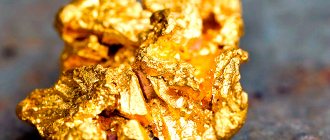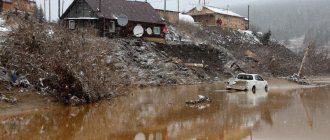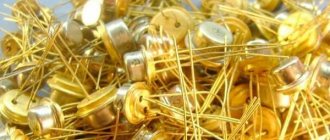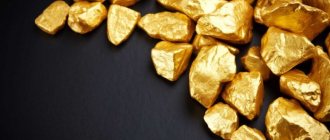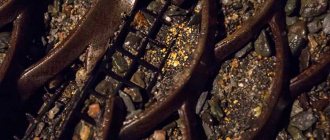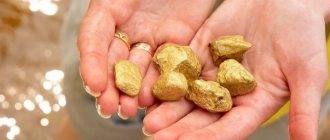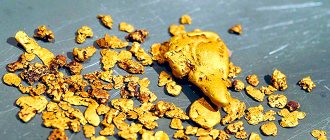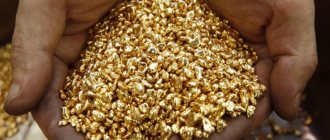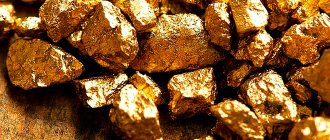Gold mining in the Perm region began at the beginning of the 18th century. The region was famous for its rich lands in earlier times. In addition to the fact that they contain large quantities of gold in the form of placers, there are also various precious stones. These lands also became known due to the discovery of diamond deposits.
Such a large accumulation of various precious minerals and metals, as well as minerals, is characterized by the formation of the main relief where the region is located today. The crust layer took 250 million years to form. During this time, the Ural ranges and mountains were formed, which are part of today's region.
Over several hundred million years of crustal movement, various types of metals, including gold, as well as minerals, entered the upper layers of the earth. The rivers that dot the region are called gold-bearing, since their silty rocks contain a significant part of the natural wealth. There are more than 40 of them in total.
In addition to gold, the following is mined in Perm:
- oil;
- iron ore;
- peat;
- facing stone;
- limestones;
- chrome ore;
- diamonds
- and other precious metals and minerals.
According to various geological surveys, land reserves contain a large number of deposits at a depth of up to 500 meters. The main part of gold placers is located in sandy deposits in coastal zones. Rivers carry small grains of eroded rocks from the Ural mountains.
Mainly in the region, in the river basins, gold is found in the form of small plates less than a quarter of a millimeter in size. Such plates are found in almost all rivers. Dimensions can reach up to 0.1 millimeters. Shapes of gold in this form may vary. Depending on the rivers where they were washed, they may be needle-shaped or have ragged edges.
Experts in gold mining say that the size and shape of a grain of sand can determine which river it came from.
An abundant accumulation of placers is located in the northwestern part of the region. Today, there are more than 9 industrial enterprises operating there, the main task of which is aimed at extracting precious metals from river basins and upper layers of the earth.
Historical reference
Gold has been actively mined in the country since the late 17th and early 18th centuries. The first large placers were discovered in the Perm region.
This is the first territory in Russia where gold began to be produced on an industrial scale. However, at that time the precious metal was not given due attention. In those days, another resource was needed in large quantities - copper.
The state did not legally regulate the extraction of valuable rocks, and most of them were mined using artisanal methods. There were many prospectors in the region who came from different parts of the country to get at least a few hundred grams per season.
The first to discover gold was a local resident of a village located near the Berezovka River, where the city of Yekaterinburg now stands. This was the first gold discovered in the country. In the Perm region, gold placers were discovered in large quantities, 20 years after the gold rush swept the country. These were the first large deposits that were actively developed at that time.
Gold deposits in the Urals and their map
Gold deposits in the Urals and their map are of concern to many who want to try their hand at gold mining. It is worth knowing that most of the mines (about 70%) currently operating are concentrated in three main regions of the Urals - Tyumen, Chelyabinsk, Sverdlovsk. Mines are represented in smaller quantities in the Orenburg region, Northwestern and Volga districts, and Bashkortostan. The bulk of the deposits are gold ore and complex mines, but the share of placers does not exceed 17%.
Worth knowing! About 75% of alluvial gold is mined in the Sverdlovsk region, and over 71% of the gross gold production is produced in the Chelyabinsk region, which is famous for its ore deposits.
The most popular primary deposits are:
- Kochkarskoe;
- Berezovskoe.
- Bereznyakovskoe.
- Svetlinskoe.
- Vorontsovskoe.
Among the promising placer mines are Staro-Marininsky, Kazansky, Suleimenevsky and Severo-Svetlinsky.
You can take a look at the map below. From it it is clear that gold is concentrated throughout the entire territory of the Ural Range, somewhere in large and somewhere in smaller volumes. The reason for such a natural miracle can be called the collision of two tectonic plates, which led to the formation of mountains and minerals in them. Especially a lot of gold is contained in lava masses. In fact, they are the main source of precious metal in the Urals.
Village "Golden Crafts"
A village was created at the site where miners were extracting precious metals from rocks. 1824 is considered the official date for the start of mass mining of placer gold. A year later, almost 2.5 kilograms of the precious metal were mined.
After 6 years, production increased tenfold and amounted to about 44 kilograms. The record year at that time was 1948 - then 350 kilograms of gold were mined, and in parallel, prospectors in the same year extracted almost 250 kilograms of platinum. These were the first major gold mining figures throughout the country.
At the same time, copper mines began to be actively developed. In that century, copper was in great demand. Therefore, all the main efforts were aimed at processing this particular ore. Only prospectors who independently worked on the territory paid attention to the gold mines. Using their own funds, they organize the production and extraction of gold in the area of the village.
The village is known not only as the country's first developed gold placer deposit. The country's first diamonds were also discovered on its territory.
Expansion of resource extraction territory
In addition, valuable types of marble were mined in this area, from which famous sculptors of Europe created their cultural objects.
Each year, teams of prospectors actively moved up the beds of local rivers from the location of the village, penetrating into the most inaccessible places. Thanks to their efforts, new deposits and placers were discovered.
Maps of places with possible deposits of valuable ores and precious stones were compiled. At the same time, deposits of building materials and raw materials were discovered. Until 1900, the region began to be actively explored by geological communities.
World fame
In the mid-18th century, Western companies also paid attention to the Perm region. Until the discovery of valuable minerals and rocks in Europe, geologists were of the opinion that gold and many precious stones were formed in the soil due to direct exposure to the sun's rays.
Therefore, Russia was not of great interest to gold miners around the world in those years, since it was believed that the entire territory of the country was covered with snow and ice most of the time, and the sun could not have a positive effect on the soil for the formation of ore in it.
Their theory was refuted after visiting the mines and confirming the fact that the country had more reserves than were known anywhere else at that time. In Western countries, the extraction of precious natural resources is beginning to be actively discussed, and many companies are seeking to invest money in existing enterprises.
Thanks to such investments, the region received significant funding for that time, and the growth in the volume of extracted material began to increase by 25-30% every year. France took active action. Entrepreneurs of this country received concessions for the extraction of many resources. Pig iron was mined in large quantities on the mountain ridges, which in those years was actively purchased by Western countries.
The French also built a smelting plant on the territory of the region, where they processed the mined iron ore and smelted ingots from it, which were transported further along the rivers on barges to large centers.
Gold and iron
In the 19th century, the main industrial activity on Vishera was iron ore mining and ferrous metallurgy. The developing “iron-making” infrastructure contributed to the development of gold deposits in sparsely populated areas. After all, for the mines it was necessary to import technological equipment, work horses and fodder, workers and food for them. Advanced technological techniques and trained personnel were positively received by the gold mines. In the ferrous metallurgy of Vishera, the activities of Prince are of interest. S.E. Lvov in Pozhva as the manager and then the owner of the Pozhevsky (Pozhvinsky) metallurgical plant, the history of which begins in 1754. There are several characteristics of Sergei Evgenievich given by his contemporaries, according to which he was called the personification of the type of enterprising entrepreneur-capitalist of the “new formation”. One of the merchants said: “It was never heard of and it was impossible to think that a master would work like that, meticulous and simple in all matters, he could shake hands with every person, he would talk to everyone, he would not disdain anyone. No, no, we have no one against him, no one can.” It had to be understood this way, explained Lvov’s brother Georgy, known for being the head of the Provisional Government of Russia in March–June 1917, that in him, S.E. Lvov, they saw a new phenomenon - a gentleman-worker, absolutely extraordinary, they recognized his efficiency and respected him for his work and simplicity. At the beginning of 1918, all Lvov property was nationalized. Prince S.E. Lvov did not emigrate abroad and lived in Russia (periodically subjected to repression) until his natural death in 1937. ________________________________________________________________________________________________
The Legend of the Lost Gold of the French
Local residents and old-timers still tell various stories about the activities of the French. They mined ores under a contract together with workers from Europe and local residents who were hired by them at the enterprise in order to receive extra income in addition to fishing.
Then many began to talk about the fact that not only pig iron was mined on the ridge for export, but also gold. In order to illegally take it outside the state, cavities were made inside the cast iron ingots into which the mined gold was cast. All actions took place in the plant they assembled.
One day, a barge with such ingots was rafting down the Vishera River to its destination and was holed. As a result of this, water began to flow into the compartments where the cast iron ingots were. Under the large mass of iron, the barge quickly sank to the bottom.
After this information reached the owner of the enterprise, he urgently moved from France to the scene of the incident. Everyone who saw the owner at that moment describes his excited emotional state. The shipment being transported was not large, but for some reason the entrepreneur panicked excessively.
A little later, he announced a big reward for the one who would get all the sunken ingots, but no one could find anything at the bottom.
First major finds
For the first 70 years of operation, gold was mined in the form of placers, which were obtained by panning at river mouths and by working on mountain ridges that were rich in gold-bearing quartz veins. The volumes of production were constantly growing and the industry, without changing its course in production, used only methods that were available at the very beginning, when the deposits were discovered.
But a situation arose due to which the miners decided to reconsider their approaches to work. At the end of the 19th century, reports of nuggets found in the region began to arrive. At first these were small pieces of gold rock, weighing no more than 20 grams. All of them were found in the mountainous areas of the region near gorges and coastlines located near the rocky rocks of the mountains.
Later, after the decision was made to mine the rocks in these areas, prospectors discovered real gold giants. In 1890, nuggets weighing up to 500 grams began to fall into the hands of workers at gold mining enterprises.
Such finds significantly increased annual production overall. Until 1914, all enterprises in the region produced approximately 1000 tons of gold. Based on this, we can conclude that up to 50 tons of precious metal were mined per year. Production, starting from the first years, has increased almost 1000 times.
About technology
Gold mining at the Vishera and Pechera placers was carried out by the most primitive means: with the help of a cradle and, at best, at American locks, without systematic exploration, which often ruined the whole business.
The gold-bearing strip of the mine was not fully developed. The sides of the cuts with lower gold content remained untouched. Subsequently, they fell into the hands of miners and predators, which led to complete clogging of the mine with dumps. Dredging could be successfully used along the river systems of Vishera, Moiva, Velov, Ulsa, Yazva, Unya, Malaya Pechera and others with a total length of 1000 miles. However, nothing was adopted regarding intelligence in this direction before the Soviet regime. One of the explanations for the slow development of gold mining in the Vishera region was considered to be complete lack of roads.
In the 1860s, in the neighboring Gorno-Zavodsky district, there were eight gold-washing factories, equipped with 16 cast-iron bowls and two iron butars with ten cradles. In addition, 18 cradles stood on streams and small rivers. Centrifugal pumps supplied water to the washing bowls. Bowls and pumps, in turn, powered locomotives and water wheels. Sands were transported by wheelbarrows and trolleys along “horse-rail” tracks about 5 miles long.
Primitive technologies and incompetent development of deposits led to the fact that a lot of gold remained on Vishera not only for Soviet times (Uralzoloto PA trust), but also for today, tomorrow and even the day after tomorrow.
Changes in the region's mining policy
After the revolution and the departure of a number of foreign enterprises from the country, production volumes began to decline sharply. Later, other found deposits of precious metals began to be developed. Then they actively began to develop the territories of both Siberia and the Far East.
New large mining enterprises appeared, for the development of which the government of that time actively allocated money. Gold mining dropped to a minimum in the Perm region after the 40s of the 20th century. More popular clusters for the extraction of other valuable resources were allocated on its territory.
First of all, the mining enterprises left over from the gold industrialists were converted to diamond mining. After their discovery at the beginning of the last century, scientists more than once carried out examinations of the rock where the precious stones were found, and came to the conclusion that the lands contain large reserves of the most valuable minerals on Earth.
With the development of industry, large volumes of fuel raw materials were required. The following began to be mined in the region:
- oil;
- gas;
- peat;
- coal.
Materials for construction were also supplied from here in large quantities. Thanks to this, the region began to actively develop and more than once became a leader in the country in many sectors of the economy.
By whom and how is it mined?
Gold is still mined in the Perm region today. However, modern legislation has introduced a number of restrictions due to which not everyone is able to run such a business. It is not profitable for large industrialists to invest large amounts of money in the development of mines, since the deposits estimated according to the latest data will not be able to recoup all costs after their development.
Mostly, gold panning is carried out by small entrepreneurs, who sometimes independently, having received all the appropriate permits, begin to mine gold sand from river mouths. To mine gold in the Perm region, prospectors do not use complex and expensive equipment.
Manual labor involves the use of:
- washing trays;
- prom. devices;
- mini drag
Pans are one of the very first tools for extracting precious metal from rivers. With their help, the silty rock of the bottom, where gold particles settle, is washed through a special sieve. All unnecessary waste material is washed off with water. After several such passes, small gold crumbs begin to form at the bottom of the tray.
Prom. The devices are mainly assembled by hand by miners and replace manual labor by automating it. These are several metal meshes and trays onto which muddy rocks are constantly loaded for washing. A stream of water is supplied to the device using a pump to clean and search for gold inclusions.
Gold is also mined in the region through mini-dredging. This is the most difficult of the methods listed. Dredges have several washing sections up to 10-15 meters long. With their help, you can wash up to 1 ton of rock in one go.
The main gold deposits of the Perm region
All mines in the Perm region can be divided into 4 groups according to their geographical location:
- Western – “Sofye-Alekseevskoye”, “Pervomaiskoye”, etc.;
- Northern – “Primorskoe”, “Salyut”, “Yagodnoe”, etc.;
- Southern – “Askold”, “Krinichnoye”, “Porozhistoye”, “Pasechnoye”, etc.;
- Central Sikhote-Alin - “Malinovskoye”, “Glukhoye”, “Blagodatnoye”.
Field map
Several years ago, the Rosgeologiya holding, by decree of the government, decided to compile a detailed database of all mineral resources available in Russia. In this regard, in 2017, one of the holding participants (JSC Geokarta-Perm) announced the search for ore gold in the Perm region. Based on the results of the development, it is planned to draw up a map of the gold content of the region.
Production volumes
Mostly, gold remains in the region only in the form of placers, which are mined through panning. No large deposits of nuggets have yet been found in the 21st century. Over the past 10 years of work by miners, the volume of gold mined per year is 80-100 kilograms. Compared to other regions where mining takes place, these figures are quite low.
In total, work is underway on the reclamation of gold sand in 8 deposits in the region. In each place, gold grains of different sizes and weights are mined.
| Deposit name | Average size of gold chips in millimeters | Milligram of gold per 1 cubic meter meter |
| Cone | 0,6 | 0,8 |
| Cheryomukhov Cape | 0,2 | 25 |
| Pecherskoe | 0,1 | 55 |
| Troshkovskoe | 0,75 | 39 |
| Black | 0,3 | 90 |
| Mordvinskoe | 0,15 | 0,9 |
| Ivanovskoe | 0,75 | 80 |
| Korminskoe | 0,2 | 45 |
As can be seen from the table, the largest crumbs mined in the region are located at the mouths of rivers in the territories of the Troshkovskoye and Ivanovskoye deposits. These places are also leaders in rock density per 1 cubic meter of cultivated land. Of the 8 listed, only 2 of these deposits are being actively developed today.
Verkhnekamskoye potassium deposit
The Perm region is very generous in mineral resources - more than 500 of them in the region’s portfolio are proof of this. One of the largest pearls of the subsoil of Perm the Great is the Verkhnekamskoye potassium deposit - a huge salt lens with an area of about 8.1 thousand square meters, formed tens of millions of years before the appearance of the first dinosaurs.
The first salt in the Kama region began to be produced back in the 15th century from salt brine, but the opening of the primary potash pillar occurred only at the beginning of the 20th century during the sinking of the Lyudmilinskaya well in Solikamsk . The industrial development of the Verkhnekamsk potash deposit began in 1934 with the creation of the Solikamsk potash plant, from which Uralkali (Berezniki) and Silvinit (Solikamsk) . In 2011, these companies merged again into one after the merger of Silvinit with Uralkali . Currently, the combined enterprise occupies 18% of the global potash fertilizer market, producing more than 11.5 million tons of potash products with revenue of more than $2.2 billion per year.
Uralkali potash mine
Five years ago I already had the opportunity to go down to the Uralkali potash mine, and now I have the chance to repeat the excursion again. Briefing, putting on special clothing, a flashlight on my helmet and a “self-rescuer” over my shoulder - in this form I am ready to descend into the bowels of the planet.
The barrel cage of BKPRU-4 in a few minutes lowered us to a depth of minus 430 meters of sea level - a diesel “Mole” with a trailer for transporting people was already waiting at the exit. On my last descent, I was quite surprised by the presence of a UAZ-goat underground, which for 20 minutes rushed through dark adits to the place of part-time work. This time the part-time job was closer - the journey underground took no more than 15 minutes.
Right or left? It’s really very easy to get lost here, but each of the lanterns has a sensor by which the dispatcher can track the presence of people in the mine
To give you an idea of the size of the underground mountain city, the distance between Berezniki and Solikamsk is about 30 kilometers on the surface of the earth, which can be covered in 15–20 minutes by car. In fact, this entire space, as well as parts of Berezniki and Solikamsk , are located above an underground mine, and this gives rise to the well-known problem of failures.
Despite the fairly spacious tunnels, maneuvering through them on our “locomotive” is not so easy. To turn around, the driver has to drive to large chambers, next to which, as a rule, there are exits to conveyor belts. It’s noisy near the conveyor - in addition to the conveyor itself, ventilation also contributes to the cacophony of sounds, which drives air from the surface.
Conveyor - along it the mined sylvinite rises to the surface to the processing plant
A short walk to the mining site, and here in front of us is an iron monster that is fighting around the clock with stubborn rock - a potassium mining machine .
Depending on the model, this beast weighs 90–110 tons with a consumption of about 0.5–0.7 mW. During the first excursion during its launch, I almost screamed out loud - “Finally, you’re back, Optimus Prime!” This time I was already prepared for the invasion of an alien race.
It's going to be hot now!
With these cutters the harvester bites into the sylvinite pillar.
The machine in operation raises clouds of salt dust - it is better not to lick your lips, but there is a persistent feeling of sea inhalation in your nose.
Finally, a short walk through the mine - the individual chambers are very voluminous, they are entire underground halls!
Silvinite - for hundreds of millions of years this salt has rested in these depths, and in months it will help in growing crops
The walls of the cells are a special creation of nature. You can enjoy these patterns for a long time
That's all. Glory to the robots.
